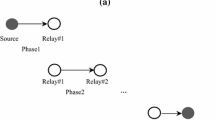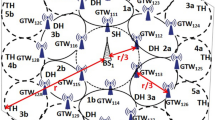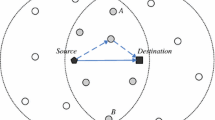Abstract
In next generation communication systems, a multi-hop scheme, in which stations between a mobile terminal and a base station relay signal transmissions, seems a promising ap-proach for wide-area coverage and system capacity enhancement. Another prospective benefit for multi-hop scheme is the reduction of transmission power for a link. This reduction is expected by splitting the transmission into a series of hops using the other mobile stations as repeaters which provide a gain from receiver (Rx) to transmitter (Tx). In this way, the transmission power is expected to become less due to the non-linear nature of the path loss. In this work, different path loss models are examined for multi-hop communication systems. Direct communication and the multi-hop communication cases are compared according to different path loss models. The question of how path loss changes by splitting the transmission into a series of sub-paths is also investigated. The investigations show that it is not possible to reduce the path losses except for some cases thus the transmit power. On the other hand using the multi-hop scheme makes possible to increase the coverage area of the network and also reduce the dead spots in the cell.








Similar content being viewed by others
References
Shah, R., Tuan, T., Sheets, M., Rabaey, J. M., Nikolic, B., Sangiovanni-Vincentelli, A., & Wright, P. (2001). Design Methodology for PicoRadio Networks. In Proceedings of design automation and test in europe (DATE), pp. 314–325.
Yamao, Y., Fujiwara, A., Murata, H., & Yoshida, S. (2002). Multi-hop radio access cellular concept for fourth-generation mobile communications system. In The 13th IEEE international symposium on PIMRC.
Lauridsen, M., Berardinelli, G., Sorensen, T. B., & Mogensen, P. E. (2014). Ensuring energy efficient 5G user equipment by technology evolution and reuse. In The 79th IEEE vehicular technology conference.
Muqattash, A., Krunz, M., & Ryan, W. E. (2003). Solving the near–far problem in CDMA-based Ad Hoc networks. Ad Hoc Networks Journal, 1, 435–453.
Kumar, K. J., Manoj, B. S., & Murthy, C. S. R. (2002). On the use of multiple hops in next generation cellular architectures. In Proceedings of IEEE international conference on networks (ICON), pp. 283–288. Singapore.
Fujiwara, A., Takeda, S. & Yoshino, H. & Otsu, T. (2002). Area coverage and capacity enhancement by multihop connection of CDMA cellular network. In Proceedings of IEEE vehicular technology conference, pp. 2371–2374. Fall.
Karlsson, R. S., Aniktar, H., Mikkelsen, J. H., & Larsen T. (2005). Performance of a WCDMA FDD cellular multihop network. In The 13th IEEE international symposium on PIMRC.
Fujimoto, K., & James, J. (2001). Mobile antenna systems handbook (2nd ed.). Norwood, MA: Artech House, Inc.
COST231 working group. (1991). Urban transmission loss models for mobile radio in the 900- and 1800-MHz bands. COST231, TD(973)119-REV(WG2).
Arnbak, J. (1993). Mobile radio propagation lecture note. Delft, The Netherlands: Delft University of Technology.
Chang, K. (2000). RF and microwave wireless systems. New York: Wiley, Inc.
Rappaport, T. (2002). Wireless communications: principles and practice (2nd ed.). Upper Saddle River, NJ: Prentice Hall.
Hata, M. (1980). Empirical formula for propagation loss in land mobile radio services. In IEEE transaction on vehicular technology, pp. 317–325.
Walfisch, J., & Bertoni, H. L. (1988). A theoretical model of UHF propagation in urban environments. IEEE Transactions on Antennas and Propagation, 36, 1788–1796.
3GPP. (2003). Radio frequency system scenarios. 3GPP technical report. TR 25.942 v6.1.0.
Author information
Authors and Affiliations
Corresponding author
Rights and permissions
About this article
Cite this article
Aniktar, H., Bulus, U. Relay Multi-hop Communications for Next Generation Mobile Networks: Investigation of Path-Loss Models. Wireless Pers Commun 88, 897–910 (2016). https://doi.org/10.1007/s11277-016-3218-8
Published:
Issue Date:
DOI: https://doi.org/10.1007/s11277-016-3218-8




